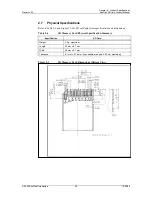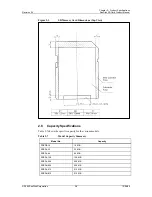
Chapter 1 – Introduction
Revision 2.2
SanDisk SD Card Product Manual
© 2004 SanDisk Corporation
1-1
12/08/04
1 Introduction
1.1 General
Description
The SanDisk Secure Digital (SD) Card is a flash-based memory card specifically designed
to meet the security, capacity, performance and environmental requirements inherent in
next generation mobile phones and consumer electronic devices. The SanDisk SD Card
includes a copyright protection mechanism that complies with the security of the SDMI
standard, and is faster and capable of higher memory capacity. The SD Card security
system uses mutual authentication and a “new cipher algorithm” to protect against illegal
usage of the card content. Unsecured access to the user‘s own content is also available. The
physical form factor: pin assignment and data transfer protocol, with some additions, are
forward compatible with the SD Card.
SanDisk SD Card communication is based on an advanced nine-pin interface (clock,
command, 4xData and 3xPower lines) designed to operate in a low voltage range. The
communication protocol is defined as part of this specification. The SD Card host interface
supports regular MultiMediaCard operation as well. In other words, MultiMediaCard
forward compatibility was kept. The main difference between the SD Card and
MultiMediaCard is the initialization process. Matsushita Electric Company (MEI), Toshiba
Corporation, and SanDisk Corporation defined the SD Card Specification originally.
Currently, the Secure Digital Association (SDA) controls the specifications. The SanDisk
SD Card was designed to be compatible with the SD Card Physical Specification.
The SD Card Interface allows for easy integration into any design, regardless of
microprocessor used. For compatibility with existing controllers, the SanDisk SD Card
offers, in addition to the SD Card Interface, an alternate communication protocol based on
the SPI standard.
Currently, the SanDisk SD Card provides up to 1024 million bytes of memory using flash
memory chips, which were designed especially for use in mass storage applications. In
addition to the mass storage specific flash memory chip, the SD Card includes an on-card
intelligent controller which manages interface protocols, security algorithms for copyright
protection, data storage and retrieval, as well as Error Correction Code (ECC) algorithms,
defect handling and diagnostics, power management and clock control.
Figure 1-1
SanDisk SD Card Block Diagram
Flash
Modules
SanDisk
Single Chip
Controller
Control
Data In/Out
SD Bus/SPI Bus
Interface
SanDisk SD Card






































